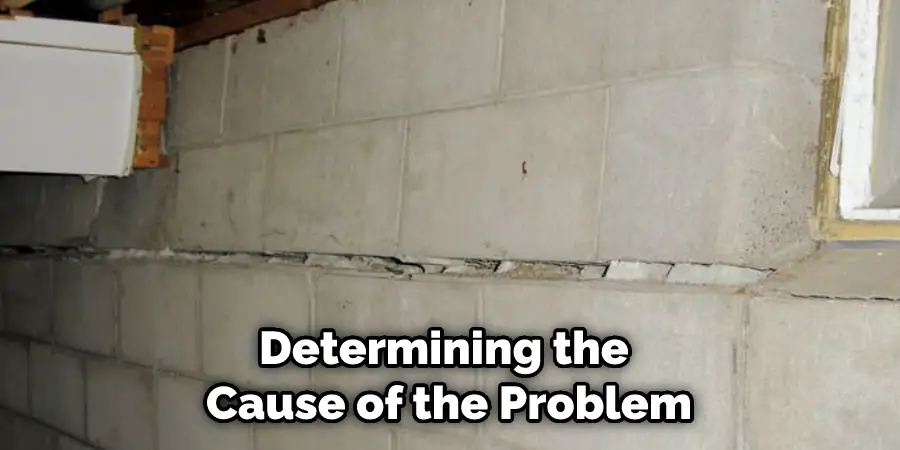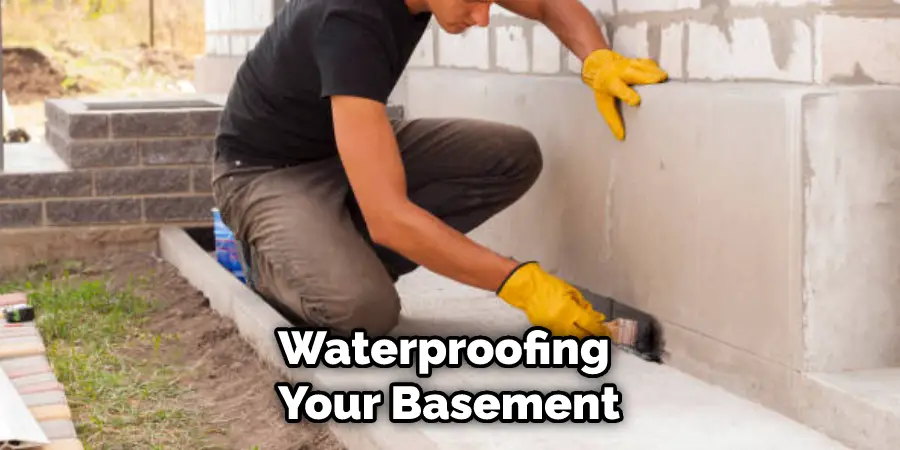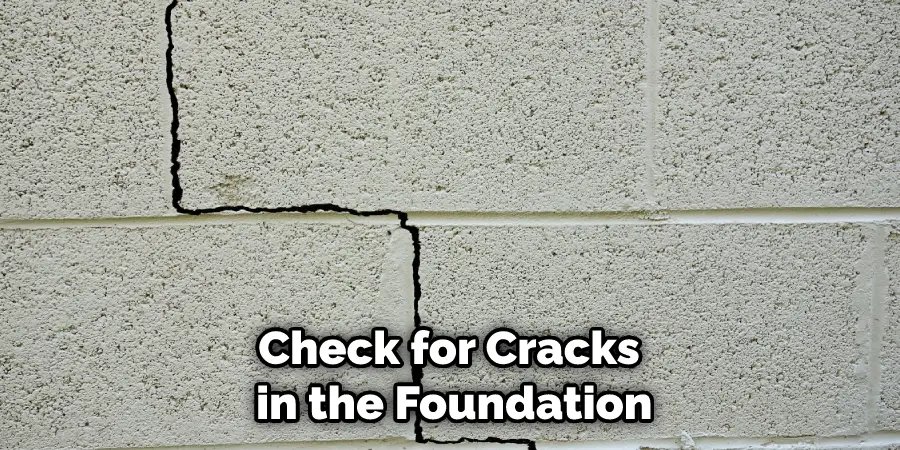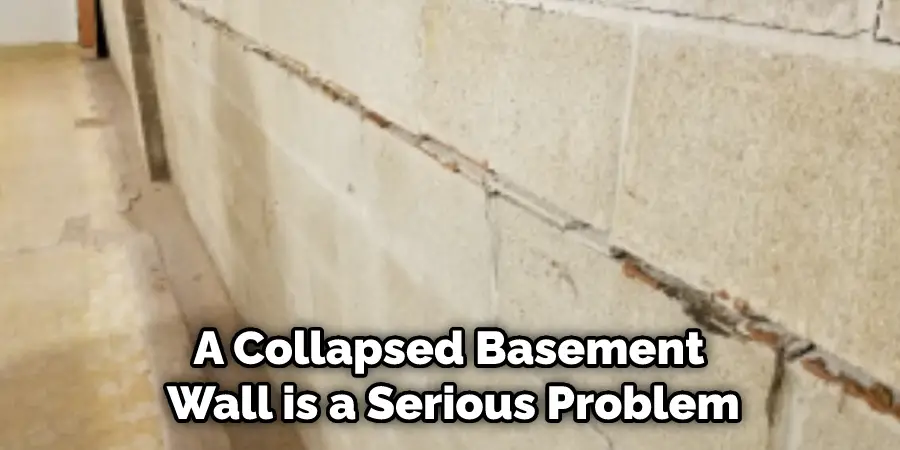If you have a basement, there’s a chance you’ve had to deal with water in your basement at some point. Whether it’s from a flood, heavy rains, or simply condensation, water can damage the walls of your basement and lead to serious problems like mold growth and foundation damage.
One of the most common issues caused by water in the basement is a wall that is caving in. If you have a wall in your basement that is caving in, don’t panic! In this blog post, we’ll walk you through how to fix a basement wall that is caving in.

What Is a Basement Wall that Is Caving In?
A wall that is caving in is a serious structural issue that should be addressed immediately. If you have a basement, it is important to inspect the walls regularly for any signs of cracking or bulging.
If you notice any problems, it is best to call a professional for an evaluation. Sometimes, a small amount of repairing may be all that is needed.
However, if the problem is more severe, the entire wall may need to be replaced. Caving walls can be caused by various factors, including water damage, settling foundations, and poor construction. No matter the cause, it is important to take action quickly to avoid further damage to your home.
Why Should You Fix a Basement Wall that Is Caving In?
A basement wall that is caving in can be a serious problem. If left unaddressed, it can cause the entire foundation of your home to become unstable. In addition, a collapsing basement wall can create a hole in your home that allows water and pests to enter.
Therefore, if you have a basement wall that is beginning to cave in, it is important to have it repaired as soon as possible. A professional contractor will be able to stabilize the wall and prevent further damage to your home.
In addition, repairing a collapsing basement wall can also help to improve the value of your home. Therefore, if you have a problem with a basement wall, don’t hesitate to call a professional for help.
How to Fix a Basement Wall that Is Caving In: Step-by-Step Guide
Step 1: Determine the Cause
The first step in fixing a basement wall that is caving in is determining the cause of the problem. Several potential causes include foundation issues, hydrostatic pressure, and soil erosion.
Once the cause of the problem has been determined, it will be easier to choose the best course of action.

Step 2: Contact a Professional
If you are unsure how to fix the problem, it is best to contact a professional. A professional can assess the situation and provide you with options for repairing the wall.
Step 3: Repair the Foundation
One potential cause of caving in the basement wall is foundation problems. If this is the case, you will need to have your foundation repaired by a professional. This is not a DIY project requiring special skills and knowledge.
Step 4: Install Drainage
Another potential cause of caving in the basement walls is hydrostatic pressure. Hydrostatic pressure occurs when water builds up around your foundation and puts pressure on the walls.
To fix this problem, you will need to install drainage around your foundation to redirect the water away from your home.
Step 5: Remove Soil Around the Foundation
Soil erosion can also cause a basement wall to cave in. If this is the case, you will need to remove the soil around your foundation and replace it with new soil.
This is a project you can do yourself, but it is important to ensure that you do it correctly to avoid further damage to your home.
Step 6: Waterproof Your Basement
Waterproofing your basement is another important step in preventing basement walls from caving in. Several ways to waterproof your basement include installing a sump pump or French drain system. Waterproofing your basement will help to keep water from seeping into your home and causing damage.

Step 7: Monitor the Situation
Once you have taken steps to fix a basement wall that is caving in, it is important to monitor the situation and ensure that the problem does not recur.
You should contact a professional immediately if you notice any changes in your basement, such as new cracks or leaks. By taking proactive steps, you can keep your basement safe and dry.
If your basement wall is caving in, it is important to take action right away in order to avoid further damage to your home. By following these steps, you can fix the problem and prevent it from happening again.
How to Identify if Your Basement Wall Is Caving In?
The first thing you’ll want to do if you think your basement wall is caving in is to check for cracks in the foundation. If you see any cracks, it’s important to investigate them further to see if they’re structural or cosmetic.
If the cracks are structural, that means they go all the way through the thickness of the wall and are a sign of a serious problem. If they’re cosmetic, on the other hand, they likely won’t cause any damage to your home.
Once you’ve determined whether or not the cracks are structural, you can start looking for other signs of a cave-in. One of the most obvious signs is a bulge in the wall.
This is often caused by water seeping into the soil around your foundation and causing the soil to expand. Another common sign is doors or windows that no longer open and closes properly. This happens when a cave-in pushes the framing around them out of alignment.
If you see any of these signs, you must call a professional for an inspection as soon as possible. Trying to fix the problem yourself could worsen and put your family at risk. Keep reading for more information about how to fix a basement wall that is caving in.

How to Waterproof Your Basement to Prevent Water Damage?
Waterproofing your basement is one of the best ways to prevent water damage. There are several ways to waterproof your basement, but the most effective method is using a waterproofing sealant.
A waterproofing sealant creates a barrier between the concrete and the water, preventing water from seeping through cracks and causing damage. You can apply a waterproofing sealant yourself or hire a professional to do it for you.
Either way, it is important to ensure that the sealant is properly applied and covers all of the cracks in your basement.
In addition to using a waterproofing sealant, you can also take other steps to prevent water damage, such as fixing any leaks in your plumbing and ensuring that your gutters are clear of debris. By taking these steps, you can help keep your basement dry and free of water damage.
You Can Check It Out To Long Does Basement Waterproofing Last
How to Reinforce a Basement Wall to Prevent It from Caving In?
A collapsed basement wall is a serious problem that can cause extensive damage to your home. Fortunately, you can do a few things to reinforce your basement wall and prevent it from caving in.
One method is to install steel plates on the wall. This will help to distribute the load evenly and prevent the wall from bowing inward.
Another option is to add vertical supports, which will provide additional strength and stability. Finally, make sure to regularly check the wall for cracks or other signs of wear and tear.
Taking these precautions can help ensure that your basement wall remains strong and stable for years to come.

The Best Way to Prevent Your Basement Wall from Caving In
Basement walls are under a lot of pressure. Not only do they have to support the weight of the house above, but they also have to withstand the hydrostatic pressure of the groundwater around them.
As a result, it’s not surprising that basement walls sometimes collapse. If you want to prevent your basement wall from caving in, you can do a few things.
First, make sure that the soil around your foundation is well-compacted. This will help to reduce the amount of pressure on your basement walls. Second, install a drainage system around your foundation. This will help to relieve hydrostatic pressure by redirecting water away from your basement walls.
Finally, ensure your gutters and downspouts are clean and in good repair. This will help to ensure that rainwater is properly diverted away from your foundation. By taking these precautions, you can help to ensure that your basement wall remains intact.
You Can Check It Out How to Clean Basement Floor After Sewer Backup
How Much Does It Cost to Fix a Basement Wall?
The cost of repairing a basement wall varies depending on the severity of the damage. For cracks or small holes, you can expect to pay around $200 for materials and labor.
However, if the wall is severely bowed or has major structural damage, the cost can rise to $4,000 or more. In addition to the repair itself, you will also need to factor in the cost of waterproofing your basement to prevent future problems.
On average, waterproofing a basement costs between $1,500 and $3,000. As a result, the total cost of fixing a basement wall can be significant. However, it is important to note that this investment can help to protect your home from water damage and increase its resale value.
Conclusion
Water in your basement can cause serious damage if not dealt with immediately. One common issue caused by water leakage is a wall that starts to cave inwards.
If you find yourself in this situation, don’t worry! We’ve given step-by-step guide on how to fix a basement wall that is caving in. Just follow steps above, and your wall will be good as new in no time!
You Can Check It Out How to Keep Basement Cool in Summer
